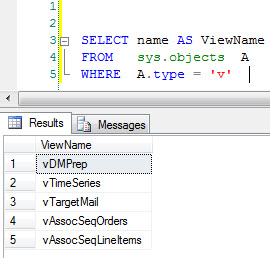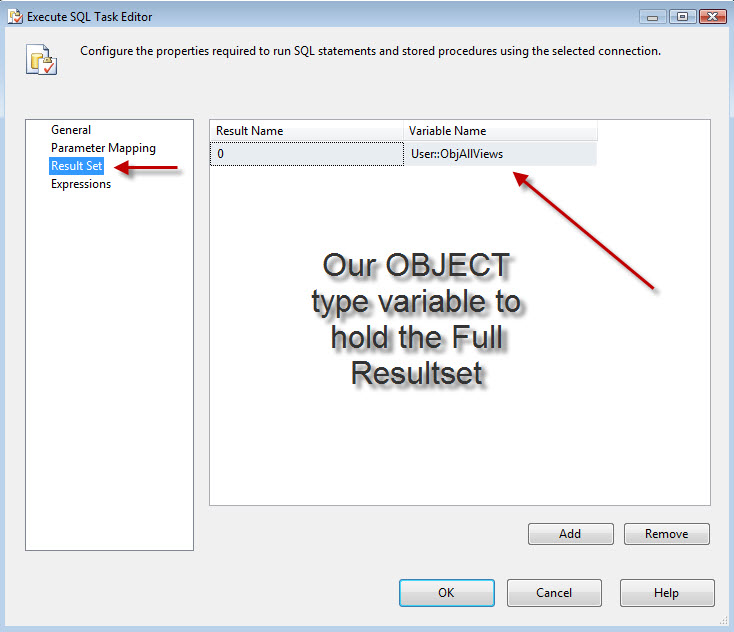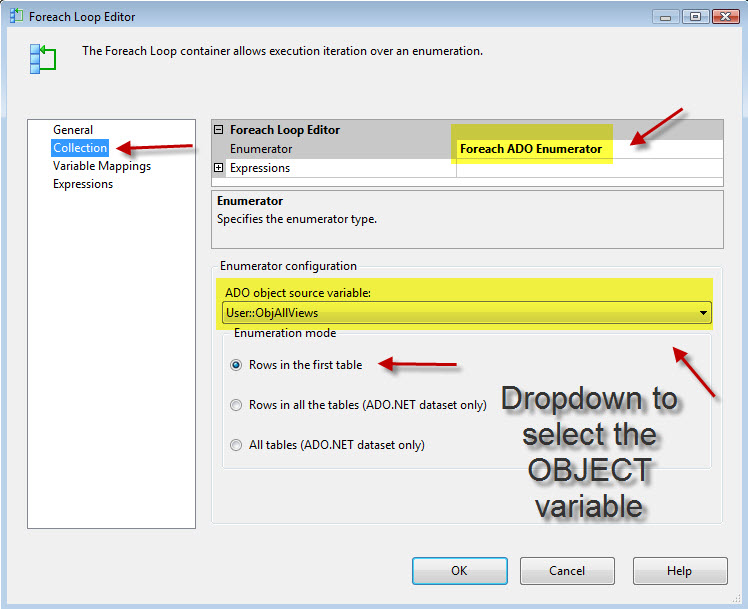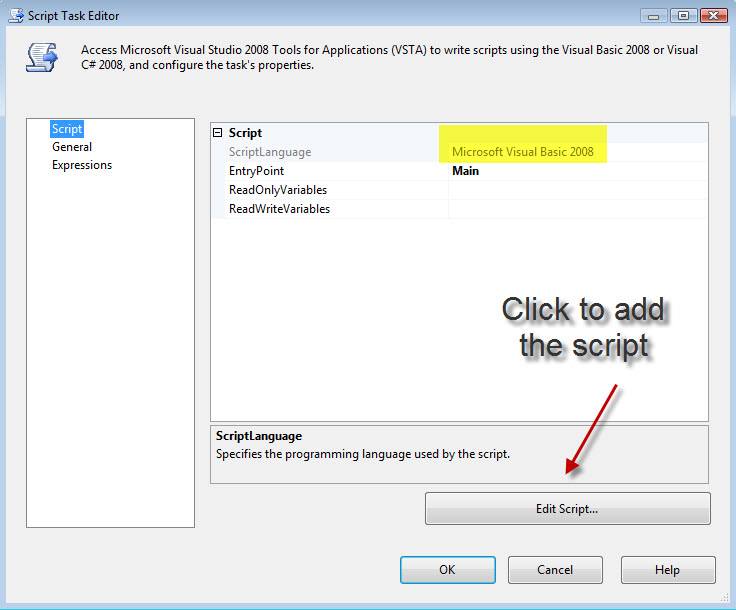Dynamically Iterate over a list of tables or views and export to flat files.
Published:
Browse All Articles > Dynamically Iterate over a list of tables or views and export to flat files.
I recently came across an interesting Question In EE and was puzzled about how to achieve that using SSIS out of the box tasks, which was impossible as SSIS can;t use on the fly columns in the source or the destination.
SO definitely only could be done using a script task, but that wasn't really my favorite part, I'm the worst when it comes to that.
Anyway because I had some past experience as developing ASP pages using vb.net, so quickly came to my mind to build a DataGrid using a SQL query, then export the grid to a text file, which worked fine, The I came across the DataReader which is a neater and easier way.
So here I'm going to demonstrate how to Iterate over a list of views which has different structure to flat file using Script Task.
I'll be using the famous "AdventureWorksDW2008R2" DB for SQL 2008 and "AdventureWorks" for SQL 2005 which could be downloaded for free here, The demo is being done on a windows Vista 64BIT machine, with SQL and VS 2008 installed. but there shouldn't be any version different if you're using SQL 2005.
Alright enough talking....
For SQL server 2008 Users......
1-The first step is to identify what are the views that we be exporting.
![Views]()
2-Check the columns count for each of them, just to illustrate the different in structure.
3-I'll create 4 Variables, I love to always to the proper naming convention to tell the data type of the variable.
![Variables]()
A-Variable "ObjAllViews" will hold back the result set which has all the views' Names.
B-Variable "StrDelimiter" will hold the delimiter that you want to use between columns, I love to use the Vertical Line "|" because most of our data has commas in it, you can get it by pressing (SHIFT + \ )
C-Variable "StrViewName" will hold each individual view.
D-Variable "StrFilePath" will hold the desired path to save the files.
4-Create a connection to your server, in my case it's 'localhost' as I've my testing SQL server on the same machine, and I named the connection 'Localhost', take note of naming the connection because it's mentioned later in the script task.
oh...so now you get the idea? we will use the "Execute SQL Task" to get us the list of the views that exists in that table into "ObjAllViews" variable, then we will use "Foreach Loop Container" to shred resultset from "ObjAllViews" variable to each individual view name into "StrViewName" variable .
Then inside the "Foreach Loop Container" we will place a "Script Task" that will do the trick for us.
Now let's go over each tasks and how it's configured....
1-The control flow and the connection
![ControlFlow and connection]()
2-Execute SQL Task
![EST1]()
![EST2]()
3-Foreach Loop Container
![FEL1]()
![FEL2]()
4-Script Task , Thanks for SIVA for helping me with the counter code.
![ST]()
5- add This code
And The results .........
![Files]()
For SQL 2005 users...
We need to change the script task, also the SQL query too as follow:
1- change the SQL query to
2- and the script task as shown here
![scripttask2005]()
Solution assumptions:
1-You're using SQL 2008 or SQL 2005.
2-Server name is "Localhost" hosted locally, otherwise, please change that.
3-You have write access to your D:\ Drive.
4-For SQL 2008 you have installed "AdventureWorksDW2008R2" DB and "AdventureWorks" for SQL 2005.
That's it...I hope my article helps someone to be more dynamic and flexible in SSIS and over come some of the Data Flow limitations.
Also I'm open to discussions and comments if you have a better way to do it.
The final package for SQL 2008 can be FOUND HERE and for SQL 2005 FROM HERE
SO definitely only could be done using a script task, but that wasn't really my favorite part, I'm the worst when it comes to that.
Anyway because I had some past experience as developing ASP pages using vb.net, so quickly came to my mind to build a DataGrid using a SQL query, then export the grid to a text file, which worked fine, The I came across the DataReader which is a neater and easier way.
So here I'm going to demonstrate how to Iterate over a list of views which has different structure to flat file using Script Task.
I'll be using the famous "AdventureWorksDW2008R2" DB for SQL 2008 and "AdventureWorks" for SQL 2005 which could be downloaded for free here, The demo is being done on a windows Vista 64BIT machine, with SQL and VS 2008 installed. but there shouldn't be any version different if you're using SQL 2005.
Alright enough talking....
For SQL server 2008 Users......
1-The first step is to identify what are the views that we be exporting.

2-Check the columns count for each of them, just to illustrate the different in structure.
SELECT A.name AS ViewName
, count(B.TABLE_NAME) AS ColCount
FROM
sys.objects AS A
LEFT OUTER JOIN
INFORMATION_SCHEMA.COLUMNS AS B
ON A.name = B.TABLE_NAME
GROUP BY
A.name
, A.type
HAVING
(A.type = 'v')
ORDER BY
ColCount DESC3-I'll create 4 Variables, I love to always to the proper naming convention to tell the data type of the variable.

A-Variable "ObjAllViews" will hold back the result set which has all the views' Names.
B-Variable "StrDelimiter" will hold the delimiter that you want to use between columns, I love to use the Vertical Line "|" because most of our data has commas in it, you can get it by pressing (SHIFT + \ )
C-Variable "StrViewName" will hold each individual view.
D-Variable "StrFilePath" will hold the desired path to save the files.
4-Create a connection to your server, in my case it's 'localhost' as I've my testing SQL server on the same machine, and I named the connection 'Localhost', take note of naming the connection because it's mentioned later in the script task.
oh...so now you get the idea? we will use the "Execute SQL Task" to get us the list of the views that exists in that table into "ObjAllViews" variable, then we will use "Foreach Loop Container" to shred resultset from "ObjAllViews" variable to each individual view name into "StrViewName" variable .
Then inside the "Foreach Loop Container" we will place a "Script Task" that will do the trick for us.
Now let's go over each tasks and how it's configured....
1-The control flow and the connection

2-Execute SQL Task


3-Foreach Loop Container


4-Script Task , Thanks for SIVA for helping me with the counter code.

5- add This code
Imports System
Imports System.Data
Imports System.Math
Imports Microsoft.SqlServer.Dts.Runtime
Imports System.Data.OleDb
Imports System.Data.SqlClient
Imports System.IO
<System.AddIn.AddIn("ScriptMain", Version:="1.0", Publisher:="", Description:="")> _
<System.CLSCompliantAttribute(False)> _
Partial Public Class ScriptMain
Inherits Microsoft.SqlServer.Dts.Tasks.ScriptTask.VSTARTScriptObjectModelBase
Enum ScriptResults
Success = Microsoft.SqlServer.Dts.Runtime.DTSExecResult.Success
Failure = Microsoft.SqlServer.Dts.Runtime.DTSExecResult.Failure
End Enum
Public Sub Main()
'Variable collection to hold the variables
Dim VarCol As Variables = Nothing
'Lock the 3 variables for read
Dts.VariableDispenser.LockForRead("User::StrViewName")
Dts.VariableDispenser.LockForRead("User::StrDelimiter")
Dts.VariableDispenser.LockForRead("User::StrFilePath")
'Fille the Variable collection
Dts.VariableDispenser.GetVariables(VarCol)
'Getting the variables' values, so we can use it later
Dim ViewName As String = VarCol("User::StrViewName").Value.ToString()
Dim delimiter As String = VarCol("User::StrDelimiter").Value.ToString()
Dim FilePath As String = VarCol("User::StrFilePath").Value.ToString()
'Construct the file name, example output: D:\vTargetMail.TXT
Dim FName As String = FilePath & ViewName & ".TXT"
'Build our Query
Dim Query As String = "SELECT * FROM " & ViewName
'Using StreamWriter
Dim writer As StreamWriter = Nothing
'Use our OLEDB COnnection
Dim connection As OleDbConnection = New OleDbConnection(Dts.Connections("Localhost").ConnectionString)
Dim command As OleDbCommand = Nothing
Dim reader As OleDbDataReader = Nothing
Try
'Checking for the file, delete if exist(you can append or rename with [File.Move(FName, Today() & "_" & FName)]
If File.Exists(FName) Then
File.Delete(FName)
End If
'Open the OLEDB connection
connection.Open()
'Run the query
command = New OleDbCommand(Query, connection)
reader = command.ExecuteReader()
If reader.HasRows Then
'Stream Writer using the FNAME that we declared erlier
writer = New System.IO.StreamWriter(FName)
While reader.Read()
'Counter to get the columns number
Dim counter As Integer = 0
Dim fieldCount As Integer = reader.FieldCount - 1
While counter <= fieldCount
If counter <> fieldCount Then
writer.Write(reader(counter).ToString() & delimiter)
Else
writer.WriteLine(reader(counter).ToString())
End If
counter += 1
End While
End While
End If
Catch ex As Exception
Dts.Events.FireError(1, "", "Something Wrong happened!!!", "", 0)
Finally
connection.Close()
writer.Close()
End Try
Dts.TaskResult = ScriptResults.Success
End Sub
End ClassAnd The results .........

For SQL 2005 users...
We need to change the script task, also the SQL query too as follow:
1- change the SQL query to
SELECT (sys.schemas.name + '.' + sys.objects.name) AS ViewName
FROM sys.objects
INNER JOIN sys.schemas ON sys.objects.schema_id = sys.schemas.schema_id
Where type ='v'2- and the script task as shown here

Imports System
Imports System.Data
Imports System.Math
Imports Microsoft.SqlServer.Dts.Runtime
Imports System.Data.OleDb
Imports System.Data.SqlClient
Imports System.IO
Public Class ScriptMain
Public Sub Main()
'Variable collection to hold the variables
Dim VarCol As Variables = Nothing
'Lock the 3 variables for read
Dts.VariableDispenser.LockForRead("User::StrViewName")
Dts.VariableDispenser.LockForRead("User::StrDelimiter")
Dts.VariableDispenser.LockForRead("User::StrFilePath")
'Fille the Variable collection
Dts.VariableDispenser.GetVariables(VarCol)
'Getting the variables' values, so we can use it later
Dim ViewName As String = VarCol("User::StrViewName").Value.ToString()
Dim delimiter As String = VarCol("User::StrDelimiter").Value.ToString()
Dim FilePath As String = VarCol("User::StrFilePath").Value.ToString()
'Construct the file name, example output: D:\vTargetMail.TXT
Dim FName As String = FilePath & ViewName & ".TXT"
'Using StreamWriter
Dim writer As StreamWriter = Nothing
'Try
'Checking for the file, delete if exist(you can append or rename with [File.Move(FName, Today() & "_" & FName)]
If File.Exists(FName) Then
File.Delete(FName)
End If
'Open the OLEDB connection
Dim connection As New OleDbConnection("Provider=SQLOLEDB;Data Source=Localhost;Initial Catalog=AdventureWorks;Integrated Security=SSPI;")
connection.Open()
Dim Query As String = "SELECT * FROM " & ViewName
Dim command As OleDbCommand = New OleDbCommand(Query, connection)
Dim reader As OleDbDataReader = command.ExecuteReader()
If reader.HasRows Then
'Stream Writer using the FNAME that we declared erlier
writer = New System.IO.StreamWriter(FName)
While reader.Read()
'Counter to get the columns number
Dim counter As Integer = 0
Dim fieldCount As Integer = reader.FieldCount - 1
While counter <= fieldCount
If counter <> fieldCount Then
writer.Write(reader(counter).ToString() & delimiter)
Else
writer.WriteLine(reader(counter).ToString())
End If
counter += 1
End While
End While
reader.Close()
End If
connection.Close()
writer.Close()
'Catch ex As Exception
' Dts.Events.FireError(1, "Nasty", "Something Wrong happened!!!", "", 0)
' Throw ex
'Finally
'End Try
Dts.TaskResult = Dts.Results.Success
End Sub
End ClassSolution assumptions:
1-You're using SQL 2008 or SQL 2005.
2-Server name is "Localhost" hosted locally, otherwise, please change that.
3-You have write access to your D:\ Drive.
4-For SQL 2008 you have installed "AdventureWorksDW2008R2" DB and "AdventureWorks" for SQL 2005.
That's it...I hope my article helps someone to be more dynamic and flexible in SSIS and over come some of the Data Flow limitations.
Also I'm open to discussions and comments if you have a better way to do it.
The final package for SQL 2008 can be FOUND HERE and for SQL 2005 FROM HERE
Have a question about something in this article? You can receive help directly from the article author. Sign up for a free trial to get started.


Comments (2)
Commented:
You can suppress the need of first execute sql task who fetch data from sysobjects with using the ADO.NET Schema RowSet Enumerator in Foreach loop, Just take a look at this type of enumerator, and then you will find out how to fetch sysobjects data with this enumerator simply.
Great job by the way, I voted for it. Hope to read more from you on SSIS :)
Reza Rad
Author
Commented:Yep, true, I could have used ADO.NET in the Foreach Loop.
Anyway there's always 100 ways to do anything :)
I was trying also to avoid BCP as it always gives me hard time, I don't know why !!
Thank you so much...for the encouraging words and the vote
Jason Yousef